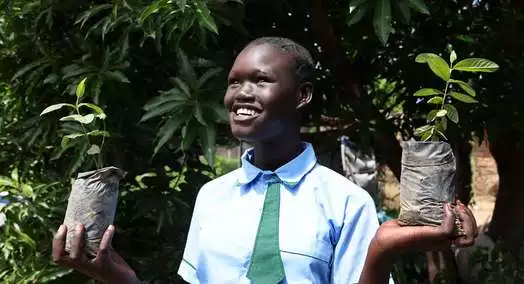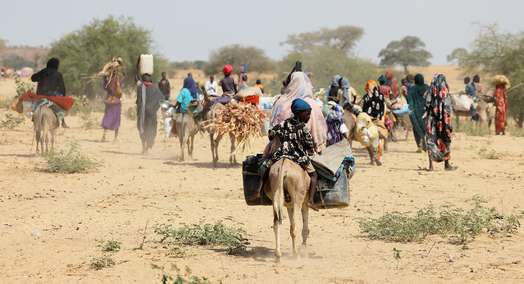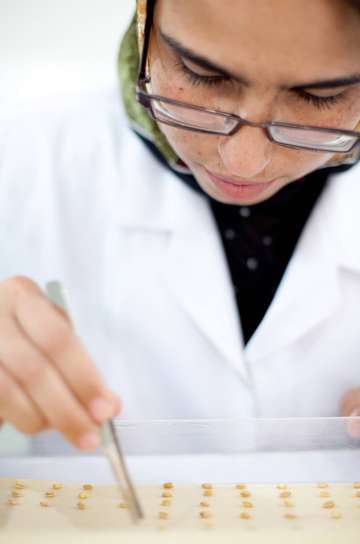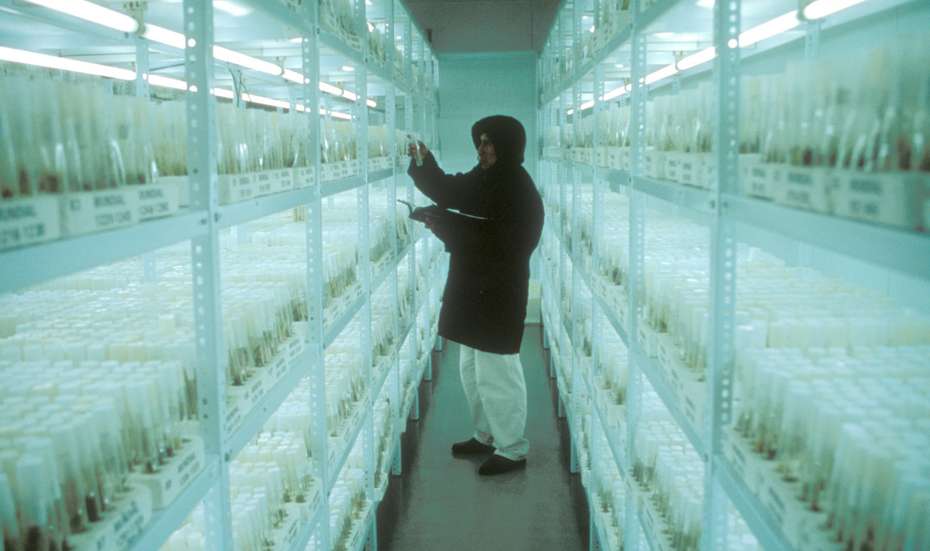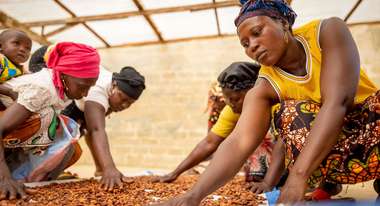"Green gold" in the digital age
Beyond biopiracy, national sovereignty is reaching its limits in the era of open-source databases.

This article was originally published in the German-language "Fachjournal Welternährung" (World Food Security Journal).
Three decades ago, when governments were just about to conclude negotiations of the United Nations Convention on Biological Diversity, few of them might have anticipated the heated debates currently evolving around the “green gold” or rather the genetic information obtained from it.
“Biopiracy” or benefit-sharing?
The Convention, the most comprehensive, legally binding international agreement addressing the variability among living organisms from all possible sources including plants, animals and micro-organisms, sets ambitious goals.
Signed by government leaders at the 1992 Earth Summit in Rio de Janeiro, Brazil it does not just commit governments to the conservation and sustainable use of biological diversity. Another objective of the Convention, ratified by 195 States, is the “fair and equitable sharing of the benefits arising out of the utilization of genetic resources, including by appropriate access to genetic resources and by appropriate transfer of relevant technologies.”
The rationale behind the objective, “access and benefit-sharing” or “ABS” is: conserving biodiversity by making it profitable. The Convention aims to reward and set an incentive for the conservation and sustainable use of the “green gold” by confirming the right of states to regulate access to their genetic resources and sanctioning their right to a fair share of the benefits arising from the use of these resources.
Financial benefits failed to materialise
Soon after the entry into force of the Convention, governments, in particular those of “mega-diverse” countries that harbor large amounts of the Earth’s biodiversity and high numbers of endemic species, complained that, notwithstanding their newly adopted ABS laws, the benefits they had hoped for had not materialized. Neither so-called non-monetary benefits in the form of, for example, new technologies had been shared with them, nor had their “green gold” generated the hoped-for financial gains.
Multiple reasons were identified at that time, including the time lag between basic biological research and translation of the resulting innovations into profitable products and the fact that not every biological innovation results in huge profits. However, many blamed a lack of compliance with ABS laws for the lack of benefit-sharing.
“Biopiracy” became an often-heard reproach – researchers and industry were accused of pirating genetic resources, bringing them outside their countries of origin and using them for research and development without sharing the benefits with their original owners.
In 2010, after seven years of negotiations, governments agreed on a supplementary agreement to the Convention. Named after the Japanese city where it was adopted, the Nagoya Protocol requires states to assist each other in the enforcement of ABS laws, including by requiring that genetic resources used for research and development within their jurisdictions have been legally accessed. The Protocol also requires its Parties to address cases of non-compliance and to cooperate in such cases.
Green gold and food security
The Nagoya Protocol with its currently 129 Parties confronts policy makers, administrators and many users of genetic resources, with serious challenges. State sovereignty over genetic resources may well clash with the demand for improved crop varieties and animal breeds, which are key for local and global food security.
Genetic resources are crucial raw material for breeders, scientists and even farmers involved in breeding activities. Genetic resources are essential for breeding higher yielding crops and highly productive livestock and for adapting them to environmental changes, including climate change, and to future human needs. Plant and animal breeders, scientists and researchers and, in fact, the world’s food security depend on the Earth’s reservoir of genetic resources.
The Nagoya Protocol itself requires its Parties to consider the importance of genetic resources for food and agriculture, their special role in food security and the interdependence of all countries with regard to these resources. But the Protocol does not provide much guidance as to how ABS laws could take these features of genetic resources for food and agriculture effectively into account. Moreover, the Protocol may create practical problems for users of genetic resources, such as plant and animal breeders.
Many food crops and animal breeds have moved and been exchanged over millennia together with people throughout the world, spurred by migration, colonization and trade. Indigenous peoples and local communities, farmers, researchers and breeders have contributed to their development, in different places and at different points in time. Whoever has studied the pedigree of a plant variety or animal breed, will appreciate that determining their country of origin is often difficult, if not impossible. With whom then need benefits to be shared where many different stakeholders contributed in different countries and at different points in time to the genetic set-up of a plant variety or animal breed?
Even farmers involved in certain breeding activities, for example the evaluation and selection of potato seedlings (Almekinders et al., 2014), may find themselves struggling with “access and benefit-sharing.” Under the Nagoya Protocol, only “research and development on the genetic and/or biochemical composition of genetic resources” trigger benefit-sharing obligations.
But there is no agreed definition of “research and development” and some national ABS laws go beyond the scope of the Protocol. Users may therefore find themselves left with tricky legal questions and no clear answers: Does the exchange of breeding material among farmers, selective breeding or hobby-breeding by seed savers trigger benefit-sharing obligations?
Digital sequence information
Beyond these practical implementation problems, the Nagoya Protocol faces another and, as some believe, existential challenge. Until recently, to use a genetic resource required possessing it physically as biological material, at least a few cells (Heinemann, 2018). Advances in biological sciences and gene sequencing, combined with the accelerating development of computing, data processing, and artificial intelligence, sometimes referred to as the Bio Revolution (McKinsey Global Institute, 2020) will make it increasingly possible to use genetic information uncoupled from biological material. The “green gold” is going digital…
Genetic information can be more and more rapidly decoded using high-throughput methods. It plays a fundamental role in environmental and biological research, contributing to the understanding of the molecular basis of life and of the ways in which genes can be used to develop new therapies and cures for diseases, new energy sources and other new products, including for food and agriculture.
Stored in openly accessible data bases, digital sequence information (DSI) is currently freely shared and, in fact, most scientific journals require that data underlying the results presented in a scientific article are made available in an open access repository before submission of the manuscript (Arita et al., 2021).
A significant amount of DSI is stored in an estimated worldwide 1,700 publicly accessible databases and repositories of biological and associated information. Three public databases based in Europe, Japan and the United States form the International Nucleotide Sequence Database Collaboration (INSDC), which is the core infrastructure for sharing DSI connecting scientific databases and platforms. Little is known about DSI databases in the private sector.
The freedom to share – and the limits of national sovereignty
Obviously, the increasing use of DSI raises the question of how countries will be able to enforce their national sovereignty over genetic resources when the genetic information that makes up these resources can increasingly be accessed by everyone through the internet and be used without accessing the original biological material.
How will they even know who the users of the genetic information obtained from their genetic resources are and how will users know whose genetic information they are using? How will benefits be shared if users no longer need to cross borders and access genetic resources and may instead access the genetic information they need virtually through the internet? And how to share benefits where comparing information of thousands or millions of different sequences contributed to the design of an entirely novel product?
Redefining benefit sharing
In a number of international fora these and related questions are currently being debated. Before the end of this year, Parties to the Convention on Biological Diversity are expected to consider DSI at their next bi-annual conference to be held in Kunming, China. Other fora struggling with legal and ethical implications of DSI include the World Health Organization and the UN Food and Agriculture Organization (FAO).
Parties to the UN Convention on the Law of the Sea discuss whether an agreement under the Convention on the conservation and sustainable use of marine biological diversity in areas beyond national jurisdiction should address ABS for DSI.
The key challenge for all of them is to balance the need to keep databases openly accessible and the demand for benefit-sharing (Leopoldina, 2021).
An important question to answer is whether the rules developed for and currently applied by many countries to genetic resources should also apply to DSI. Some fear that such a move could jeopardize the creation and, ultimately, the sharing of benefits. They refer to the “non-monetary” benefits an open access and exchange policy could generate for all countries and stakeholders.
Others point out that the availability of DSI does not mean that it is accessible for everyone in the same way. Substantial technical, institutional and human capacity is required to be able to access and make use of the innovation potential of DSI. Many developing countries are therefore disadvantaged when it comes to the use of digital sequence information.
A multilateral fund as a solution?
There seems to be growing consensus that an internationally agreed solution is necessary that ensures access to DSI and facilitates the sharing of benefits derived from it. Neither the gene nor the digital revolution can be addressed through national laws alone. A model that could inspire countries is the International Treaty on Plant Genetic Resources for Food and Agriculture adopted by FAO in 2001.
Under the Treaty’s multilateral system “facilitated access” for research and breeding is provided to a vast range of important food crops and forages. Users of these plant genetic resources share benefits through a multilateral fund – primarily with farmers in developing countries, who conserve and sustainably utilise plant genetic resources for food and agriculture.
Could a multilateral system along these lines be part of the solution for DSI? Could it ensure access to DSI and at the same time support the sustainable use and conservation of genetic resources, be it by farmers, scientists or genebanks and facilitate transfer of relevant knowledge and technologies to developing countries?
The views expressed in this article are those of the author and do not necessarily reflect the views or policies of the FAO.

